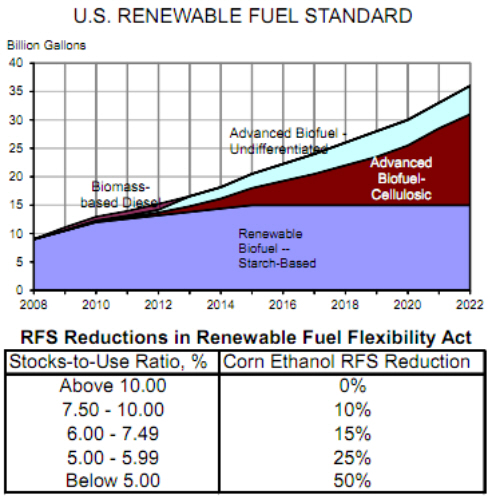



CME: Ethanol Bill Reduces Corn Usage
US - A bill introduced on 5 October in the US House of Representatives by Congressmen Bob Goodlatte (R-Virginia) and Jim Costa (D-CA) would reduce the mandated usage of corn-based ethanol if the projected US year-end stocks-to-use ratio falls below specific levels, write Steve Meyer and Len Steiner.The “off-ramp” for the Renewable Fuel Standard (RFS) has been on the wish list of livestock and poultry producer groups for some time.
The RFS mandates rising levels of blending biofuels from various sources into US fuels supplies. The category of most concern to feed users has been the increasing mandate level for cornbased ethanol.
The starch-based mandate began at nine billion gallons per year in 2008 and increased rapidly (by 1.5 billion/year) through 2010. The rate of increase has now slowed to 600 million gallons per year but that rate continues until the starch-based RFS peaks in 2015 at 15 billion gallons.
The RFS for 2011 is 12.6 billion gallons. It goes up to 13.2 billion gallons in 2012.
Beyond the starch-based mandate lies “Advanced Biofuels”, part of which is mandated to come from cellulosic feedstocks. According to a National Academy of Sciences report released last week (http://www8.nationalacademies.org/onpinews/newsitem. aspx?RecordID=13105), the technology for these products has not progressed to the point of making them economically feasible.
The ethanol industry has not met these mandates to date and, given the faster rates at which they will grow, is unlikely to do so in the future.
The Goodlatte-Costa bill focuses only on the starch-based RFS and prescribes one-year reductions in the RFS if USDA’s projected year-end stocks-to-use ration hits certain levels as shown in the table at right.
The legislation requires the Administrator of the Environmental Protection Agency (the Secretary of Agriculture has no authority over the RFS since it was part of the 2007 Energy Bill) to use the stocks-to-use ratio in the November USDA World Agricultural Supply and Demand Estimates (WASDE) report to determine if a waiver will be included in the declared RFS (ie. the actual number of gallons to be required) for the following calendar year.
In addition, the EPA Administrator will be required to re-assess the current crop year’s stocks-to-use ratio in June using the same schedule of potential waivers for the rest of the calendar year. The bill does provide an “out” to using the stocks-to-use ratio if “. . . the Administrator provides clear and compelling evidence that such a waiver would not have a material effect on the quantity of corn available for use for food and feed.” (Quoted from Rep. Costs’s summary which is available at http://costa.house.gov/).
The Renewable Fuels Standard is a key piece of US biofuels policy in that it promised and ever-growing market to ethanol producers. Research has shown that the RFS has been the key driver to the sector’s growth and will continue to drive growth even if the blenders’ tax credit and ethanol import tariff are allowed to expire on schedule at the end of this year.
The concerns of the livestock and poultry sectors, though, have not been so much about continued growth of the ethanol sector as they have been about the ability of all corn users to adjust when another truly “short” corn crop occurs.
A significant shortfall in corn production such as what occurred in drought years like 1983 and 1988 or an extremely wet year such as 1993 would require the smaller supply to be rationed among various uses and across time to assure that supplies last until a new crop can be harvested. The presence of the RFS means that ethanol plants could not participate in that process, forcing more rationing on feed users, food/industrial uses and exports.
This fear is made even worse for feed users because they cannot just shut down their production processes — animals must be fed in the short run regardless of the cost. Had this law been in effect this year, the mandate for 2011 would have been reduced by 15 per cent given last November’s S/U ratio of 6.2 per cent for the 2010-2011 crop year and then been reduced by 25 per cent given USDA’s June S/U ratio of 5.4 per cent.
USDA’s September estimate for the 2011-12 crop year was 5.3 per cent. Should that estimate hold into November and this law be passed, the 2012 RFS level would be 9.9 instead of 13.2 billion gallons.
That reduction would free up 1.18 billion bushels of corn to be used as ethanol, meat/poultry and corn prices dictate.
Given current oil, gasoline, ethanol and corn futures prices, it may well still go to ethanol. But the 1.18 billion bushels would be free to move instead of locked into one usage.












